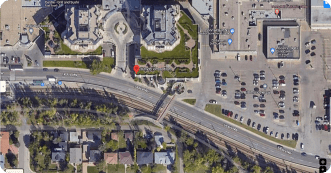In this guide, let’s dig deep into the strategic value of virtual tours for businesses in Fredericton, NB. We’ll explore the evolving digital landscape and the opportunities it presents, helping you step into the virtual realm and enhance your competitive edge.
Exploring the Variety of Virtual Tours
The term “virtual tour” is a broad concept that encompasses different types of immersive online experiences. The two primary categories of virtual tours are 360-degree tours and 3D virtual tours, each offering unique features suitable for various industries.
360-Degree Tours
A 360-degree tour offers a panoramic view of a particular location, allowing users to explore the location from every angle by merely dragging their cursor on the screen. This type of virtual tour is generated by stitching together a series of photographs taken from a single standpoint in a full 360-degree rotation.
Industries Benefiting from 360-Degree Tours:
- Museums and Historic Sites: A 360-degree tour works well for these industries, allowing viewers to explore exhibits, artifact descriptions, or historical landmarks in extensive detail.
- Education Institutions: Schools, colleges, and universities can provide 360-degree tours of their facilities and campuses, helping prospective students and parents view the learning environment and amenities offered.
- Restaurant Industry: Restaurants can showcase their ambience, decor, dishes, and even menus via a 360-degree virtual tour, offering customers a visual taste of what to expect.
- Retail Stores: Retail businesses can use 360-degree tours to provide customers with a virtual shopping experience, demonstrating product ranges, store layout, and various sections in a unique way.
3D Virtual Tours
These tours, created with technologies like Lidar or photogrammetry, allow users to “walk through” a space by capturing depth, size, and texture.
Industries Benefiting from 3D Virtual Tours:
- Real Estate: 3D virtual tours give potential buyers or renters a feel of the property. Users can navigate through rooms, switch between floors, and zoom in to inspect details, virtually “experiencing” the property before making a decision.
- Hotels and Event Venues: These industries can use 3D tours to give potential clients a realistic sense of the space, layout, amenities, and aesthetics to help with event planning or vacation selection.
- Interior Design and Architecture Firms: With 3D tours, clients can visualize proposed design changes or architectural plans, fostering better understanding and communication between designers/architects and their clients.
Behind The Scenes: Equipment and Technology for Virtual Tours
The quality of a virtual tour depends on specialized equipment and sophisticated technology, chosen based on the type of tour: a 360-degree or 3D virtual tour.
Equipment Needed for 360-degree Virtual Tours
360-degree virtual tours primarily revolve around capturing panoramic images. Essential tools for creating these tours include:
- DSLR or 360-Degree Camera: Digital single-lens reflex (DSLR) cameras capture high-quality images. In contrast, 360-degree cameras take a full surrounding shot, simplifying the process.
- Tripod: Ensures stability, preventing shaky images and facilitating a full 360-degree field of view with a panoramic head.
- Fisheye Lens (if using DSLR): Enables a wide field of view, essential for fewer image stitching.
Software Needed for 360-degree Virtual Tours
Once you have your images, you’ll need software for stitching and editing:
- Panoramic Software: Tools like PTGui, AutoPano, or Panoweaver stitch different-angle images into seamless panoramas.
- Virtual Tour Software: Weaves panoramas into a tour and inserts hotspots for interactivity and information.
Equipment Needed for 3D Virtual Tours
3D virtual tours offer a more immersive experience. To create these tours, you’ll need:
- 3D Camera: Devices like Matterport’s Pro2 3D Camera or Ricoh’s Theta Z1 capture depth, offering a realistic space representation.
Software Needed for 3D Virtual Tours
- 3D Modelling Software: Platforms like Matterport or Cupix turn 3D imagery into a navigable virtual walk-through.
Whether you’re a small or large enterprise, leveraging appropriate equipment and technology significantly impacts the viewer’s experience and the effectiveness of your virtual tours as part of your marketing strategy.
Promoting Your Virtual Tour: Reaching Your Audience
Creating an engaging virtual tour is only the first step – the next crucial step is promoting your tour to your intended audience to maximize visibility and engagement. A strategic promotional plan can succeed in introducing potential customers to your interactive content, enhancing brand visibility, and driving conversions.
Online Promotion
- Website Integration
Embed the virtual tour on your website, particularly on relevant pages. For instance, if you’re a hotel, your virtual tour can be placed on the ‘Rooms’ or ‘Facilities’ page. A real estate company might include them on property listing pages.
- Social Media
Utilize your social media channels such as Facebook, Instagram, Twitter, and LinkedIn to share links to your virtual tour. Brief teaser videos can generate interest and encourage people to check out the full tour on your website.
- Email Newsletters
If you maintain a mailing list for newsletters or updates, include a section promoting your virtual tour in your next email to subscribers. Use compelling text and eye-catching images to draw their attention.
- Virtual Tour Directories
Consider submitting your tour to virtual tour directories. These platforms showcase a wide variety of tours and can help drive tour views from interested users.
Offline Promotion
While virtual tours are digital, don’t neglect traditional offline methods:
- QR Codes on Print Materials
Print materials like brochures, posters, business cards, or banners can feature QR codes linking to your virtual tour. This is especially beneficial at events, showrooms, physical stores, or property viewings.
- Press Releases
Local newspapers or industry-specific magazines could be interested in a press release about your innovative use of virtual tour technology. Include details to access the tour to drive traffic.
The promotion strategy for your virtual tour should be tailored to your business needs and your target audience’s characteristics. Both online and offline channels can be effective to maximize coverage and reach the largest possible user base.
Navigating the Future with Virtual Tours in Fredericton
Virtual tours offer businesses an innovative way to engage and convert customers. The type of tour, quality of equipment and technology, and promotional strategy deeply impact its effectiveness. As virtual tours become integral to a digital strategy, businesses of all sizes and industries are encouraged to embrace this tool.
For businesses in Fredericton, NB, adopting this trend is made simple with 360° Vid Virtual Tours. As a committed virtual tour service, 360° Vid Virtual Tours leverages industry-leading technology and expertise to create custom virtual tours. Partner with 360° Vid Virtual Tours and shape your digital future powered by high-quality virtual tours.
What Our Clients Say
Locations
We travel Canada-wide. Don’t see your location listed? Contact us.
Provinces We Serve
Cities We Serve
Cities We Serve
Cities We Serve
Cities We Serve
Cities We Serve
Cities We Serve
Cities We Serve
Cities We Serve
Cities We Serve
Cities We Serve
Cities We Serve
Virtual Tours
Connect With Us
Are you a Business Owner? Or just have a general question? Let us know. We’re happy to help!



















